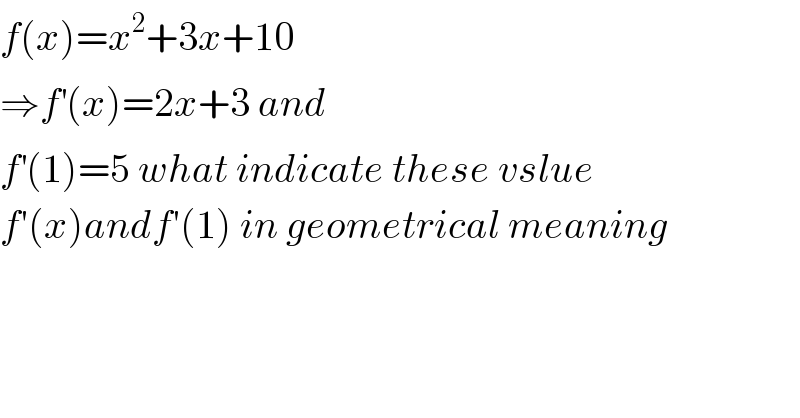
Question Number 2229 by tabrez8590@gmail last updated on 09/Nov/15

$${f}\left({x}\right)={x}^{\mathrm{2}} +\mathrm{3}{x}+\mathrm{10} \\ $$$$\Rightarrow{f}^{'} \left({x}\right)=\mathrm{2}{x}+\mathrm{3}\:{and} \\ $$$${f}^{'} \left(\mathrm{1}\right)=\mathrm{5}\:{what}\:{indicate}\:{these}\:{vslue}\: \\ $$$${f}'\left({x}\right){andf}'\left(\mathrm{1}\right)\:{in}\:{geometrical}\:{meaning} \\ $$
Answered by prakash jain last updated on 09/Nov/15

$$\mathrm{If}\:\mathrm{you}\:\mathrm{plot}\:\mathrm{a}\:\mathrm{graph}\:\mathrm{with}\:{f}\left({x}\right)\:\mathrm{on}\:\mathrm{Y}−\mathrm{axis} \\ $$$$\mathrm{and}\:{x}\:\mathrm{on}\:\mathrm{X}−\mathrm{axis},\:\mathrm{then} \\ $$$${f}\:'\left({x}\right)\:\mathrm{gives}\:\mathrm{the}\:\mathrm{slope}\:\mathrm{of}\:\mathrm{the}\:\mathrm{tangent}\:\mathrm{drawn} \\ $$$$\mathrm{on}\:\mathrm{the}\:\mathrm{curve}\:\mathrm{at}\:\mathrm{point}\:\left({x},{f}\left({x}\right)\right). \\ $$$${f}\:'\left(\mathrm{1}\right)=\mathrm{5}\:\mathrm{gives}\:\mathrm{the}\:\mathrm{of}\:\mathrm{the}\:\mathrm{tangent}\:\mathrm{at}\:\mathrm{point} \\ $$$$\left(\mathrm{1},{f}\left(\mathrm{1}\right)\right)=\left(\mathrm{1},\mathrm{14}\right). \\ $$$$\mathrm{slope}=\mathrm{tan}\:\theta,\:\mathrm{where}\:\theta\:\mathrm{is}\:\mathrm{the}\:\mathrm{angle}\:\mathrm{made}\:\mathrm{by} \\ $$$$\mathrm{tangent}\:\mathrm{with}\:{X}−\mathrm{axis}. \\ $$
